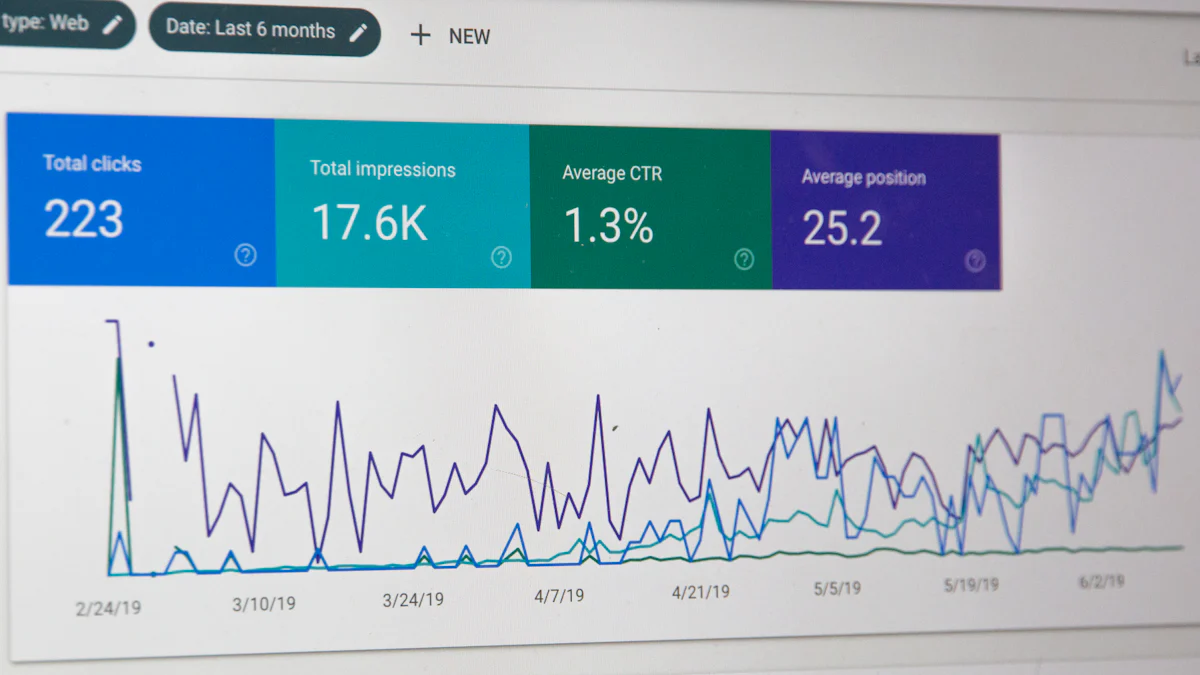Connecting Dots in Real Time: How Data Seamlessly Integrates Every Link in the Supply Chain

Supply chain efficiency drives modern business success. Companies with high-performing supply chains often achieve revenue growth above industry averages. Data plays a crucial role in supply chain management. Accurate data ensures smooth operations and informed decisions.
Real-Time Supply Chain data transforms this process. Instant insights into operations allow quick responses to disruptions. This agility enhances overall efficiency and customer satisfaction. Real-time data provides transparency, enabling better decision-making and operational flow.
Understanding Real-Time Data in the Real-Time Supply Chain
Definition and Characteristics of Real-Time Supply Chain
Real-Time Supply Chain data means having access to information as soon as it is generated. This immediacy allows supply chain managers to make quick decisions and respond to changes effectively.
Immediate Data Delivery
Immediate data delivery ensures that information reaches decision-makers without delay. This rapid access to data helps businesses address issues before they escalate. For example, if a shipment gets delayed, immediate data delivery allows for quick rerouting or adjustments to minimize impact.
Continuous Data Flow
Continuous data flow means that data keeps coming in without interruption. This constant stream of information provides a comprehensive view of the Real-Time Supply Chain. Businesses can monitor every aspect of their operations, from production to delivery, ensuring nothing falls through the cracks.
Types of Real-Time Data in Supply Chains
Different types of real-time data play crucial roles in maintaining an efficient Real-Time Supply Chain. Each type offers unique insights that help optimize various aspects of supply chain management.
Inventory Levels
Real-time inventory data lets businesses know exactly how much stock is available at any given moment. This information helps prevent stockouts and overstock situations. Automated systems can reorder supplies when levels drop below a certain threshold, ensuring continuous availability.
Transportation and Logistics Data
Transportation and logistics data provide real-time updates on the movement of goods. This data includes information about shipping routes, delivery times, and vehicle locations. Real-time tracking enables route optimization, reducing fuel costs and improving delivery times.
Customer Demand Data
Customer demand data reflects current market trends and consumer preferences. Businesses can use this data to adjust production schedules and inventory levels. Real-time analysis of sales data helps companies meet customer needs more accurately and promptly.
Benefits of Real-Time Data for Supply Chain Efficiency

Enhanced Decision-Making
Real-Time Supply Chain data enhances decision-making capabilities. Quick access to information allows supply chain managers to respond swiftly to changes.
Faster Response to Market Changes
Businesses can react to market shifts immediately. Real-time insights enable companies to adjust production schedules and inventory levels. This agility prevents stockouts and overstock situations.
Improved Forecast Accuracy
Accurate forecasting becomes possible with Real-Time Supply Chain data. Companies can analyze current trends and predict future demand. This precision reduces waste and optimizes resource allocation.
Cost Reduction
Real-Time Supply Chain data helps in cutting costs across various operations. Immediate insights lead to more efficient processes and reduced expenses.
Minimizing Inventory Holding Costs
Real-time inventory data prevents excess stock. Automated systems reorder supplies only when necessary. This practice minimizes holding costs and frees up capital for other uses.
Reducing Transportation Costs
Transportation costs decrease with real-time tracking. Route optimization becomes easier with continuous data flow. Businesses save on fuel and improve delivery times.
Increased Customer Satisfaction
Customer satisfaction improves significantly with Real-Time Supply Chain data. Timely deliveries and better product availability enhance the overall customer experience.
Timely Deliveries
Real-time tracking ensures on-time deliveries. Customers receive their orders promptly, boosting satisfaction and loyalty. Businesses can monitor shipments and address delays immediately.
Better Product Availability
Real-time demand data keeps shelves stocked with popular items. Companies can adjust inventory based on current sales trends. This practice ensures that customers find what they need when they need it.
Challenges in Implementing Real-Time Data
Data Integration
Compatibility Issues
Integrating real-time data into existing systems often presents compatibility issues. Different software platforms may not communicate well with each other. This lack of compatibility can lead to data discrepancies and inefficiencies. For example, a company might use one system for inventory management and another for transportation logistics. These systems may not share data seamlessly, causing delays in decision-making.
Data Silos
Data silos occur when information gets trapped within specific departments or systems. These silos prevent a holistic view of the supply chain. Breaking down these barriers requires significant effort and resources. Companies must invest in integration solutions that allow data to flow freely across all departments. This unified approach ensures that everyone has access to the same real-time information.
Data Security and Privacy
Protecting Sensitive Information
Real-time data often includes sensitive information. Protecting this data from unauthorized access is crucial. Cybersecurity threats pose a significant risk to supply chain operations. Companies must implement robust security measures to safeguard their data. Encryption, firewalls, and secure access protocols help protect sensitive information.
Compliance with Regulations
Compliance with data privacy regulations adds another layer of complexity. Different regions have varying laws regarding data protection. Companies must navigate these regulations to avoid legal repercussions. For instance, the General Data Protection Regulation (GDPR) in Europe imposes strict guidelines on data handling. Adhering to such regulations requires ongoing monitoring and adjustments to data practices.
Technological Infrastructure
Need for Advanced Systems
Implementing real-time data solutions necessitates advanced technological infrastructure. Legacy systems may not support the demands of real-time data processing. Upgrading these systems involves significant investment and planning. Companies need to adopt modern technologies like cloud computing and Internet of Things (IoT) devices. These technologies enable real-time data collection and analysis.
High Implementation Costs
The cost of implementing real-time data solutions can be prohibitive. Small and medium-sized enterprises (SMEs) may struggle with these expenses. High implementation costs include purchasing new hardware, software, and training staff. Despite these challenges, the long-term benefits often outweigh the initial investment. Companies that overcome these hurdles gain a competitive edge in the market.
"Real-time data means real-time problem-solving. When you spot an anomaly in the supply chain, you can take corrective action immediately before it spirals into a bigger issue." - Supply Chain Expert
Addressing these challenges requires a strategic approach. Companies must prioritize data integration, security, and technological upgrades. By doing so, they can harness the full potential of real-time data for supply chain efficiency.
Practical Applications of Real-Time Data in Supply Chains

Inventory Management
Real-Time Stock Monitoring
Real-Time Supply Chain data offers immediate insights into stock levels. Businesses can monitor inventory in real time, ensuring accurate and up-to-date information. This monitoring helps avoid stockouts and overstock situations. Companies can maintain optimal inventory levels, reducing waste and improving efficiency.
Automated Replenishment
Automated replenishment systems use Real-Time Supply Chain data to reorder supplies. When inventory levels drop below a certain threshold, the system triggers an order. This automation ensures continuous product availability. Businesses save time and reduce manual errors, leading to smoother operations.
Transportation and Logistics
Real-Time Tracking
Real-Time Supply Chain data provides real-time updates on the movement of goods. Companies can track shipments from origin to destination. This visibility helps identify delays and reroute shipments if necessary. Real-time tracking improves delivery times and enhances customer satisfaction.
Route Optimization
Route optimization relies on Real-Time Supply Chain data to find the most efficient paths. Businesses can reduce fuel costs and improve delivery times. Real-time data helps adjust routes based on traffic conditions and other factors. This optimization leads to cost savings and better resource utilization.
Demand Planning
Real-Time Sales Data Analysis
Analyzing real-time sales data allows businesses to understand current market trends. Real-Time Supply Chain data helps companies adjust production schedules and inventory levels. Accurate sales data analysis ensures that businesses meet customer demands promptly. This responsiveness enhances overall efficiency and customer satisfaction.
Dynamic Demand Forecasting
Dynamic demand forecasting uses Real-Time Supply Chain data to predict future needs. Companies can anticipate demand fluctuations and adjust inventory accordingly. This forecasting reduces the risk of stockouts and overstock situations. Businesses can allocate resources more effectively, improving overall supply chain performance.
Real-time data boosts supply chain efficiency. Instant insights allow quick responses to disruptions. This agility improves operations and customer satisfaction.
The future of real-time data in supply chain management looks promising. Advanced technologies will enhance data collection and analysis. Companies will gain even more precise control over their supply chains.
Businesses should adopt real-time data solutions now. The benefits outweigh the challenges. Real-time data transforms supply chains, making them more efficient and resilient. Embrace this technology to stay competitive and meet customer demands effectively.
See Also
Unveiling Big Data's Influence on Enhancing Supply Chains
The Crucial Role of Visibility in Optimizing Supply Chains
Transforming Supply Chain Management with Cloud-Based Solutions
The Importance of Logistics Security in Supply Chains
Optimizing Supply Chain Efficiency with JUSDA's Full Visibility
